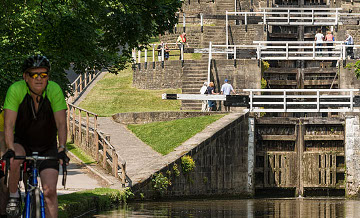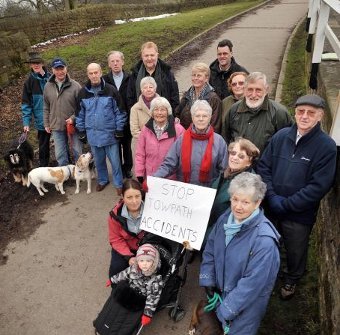Towpaths—dangerous places to be
Article Index
THE push for cyclists to take over our towpaths continues apace with the latest high speed section highlighted in (Just under half million for L&L) with the towpaths now starting to become dangerous places to be, especially if you are on foot, writes Mick Fitzgibbons.
As the Trust is pressing for visitor numbers to increase, it begs the question at what cost?
Conflict with cyclists
It is logical that as visitor numbers increase, there is bound to be an increase in the number of reported incidents. Especially where people on foot are going to come into conflict with cyclists who are habitually travelling at high speed. As there is no set speed limit for the towpath, cyclists can proceed at any pace they see fit. But while there are no speed limits on the towpath, there are speed limits in many other places such as parkland where public and cyclists are expected to share the same space.
There are sections of the towpath which from my own experience are certainly not places where I would advise people with dogs or parents with children to frequent. And certainly not without both being on a leash or restricted by child reigns for their safety. I know, you know, even CaRT knows that accidents are occurring. Over the last few boating seasons we have been involved in several incidents involving cyclist travelling far too fast for their or our safety.
 Bingley
Bingley
I was involved in an incident on the Bingley Five Rise with a cyclist coming down the steep towpath at high speed. (More accidents waiting to happen). The cyclist scraped between myself and the boat as I was handling the mooring ropes. I reported the near miss to CaRT by telephone. I heard nothing further.
 I and two other boaters reported by telephone and followed up with an email an incident in Nottingham where the paved section of the towpath is in reality a high speed carriageway. I asked if someone from the Trust would come along and assess what was a dangerous situation where adults, dogs and children were coming into conflict with cyclists. (The picture shows a group of people complaining of the danger of high speed cyclists.)
I and two other boaters reported by telephone and followed up with an email an incident in Nottingham where the paved section of the towpath is in reality a high speed carriageway. I asked if someone from the Trust would come along and assess what was a dangerous situation where adults, dogs and children were coming into conflict with cyclists. (The picture shows a group of people complaining of the danger of high speed cyclists.)
"It's dangerous stood here."
Needless to say, no one came—in a classic case of 'bury you head in the sand'—the Trust ignored the situation. Later I also reported a boat being vandalised, resulting in three people being arrested. The next morning we had a visit from the police and while we were chatting, cyclists were passing by at high speed so close you could feel the air disturbance—the police officer summed it up in a few seconds when he said: "It's dangerous stood here.".
You may also remember the incident on the Chesterfield canal (Diabolical CaRT emergency service) where we came across a member of the public suffering from hypothermia and unable to move. We contacted the ambulance and police direct. Then we and ambulance service tried to contact CaRT via their emergency number, as access was needed through an emergency gate on the towpath. This was a complete shambles.
Incidents along the Cut
We had to render first-aid and summon the emergency services to a cyclist on the Leeds & Liverpool Canal who had fallen from his bike. (A Leeds & Liverpool adventure) He had broken his shoulder and collar bone. He was drifting in and out of consciousness. His friends had to be stopped from trying to pick him up. I also reported that one to the Trust.
A cyclist travelling at high speed along the Cut in Nottingham had to swerve to avoid a member of the public. (Towpath Velodrome) Hitting a mooring ring and then being thrown from his bike. Just missing our boat windows. We had to untangle him from his bike so that he could get up. A few moments later the rest of the group turned up including the lads father who said: "Now will you slow down? Not much good passing the cycling proficiency test. I might not be able to keep up, but at least I ride safer." The group departed again at high speed.
Waiting for serious accident?
We later met a group of CaRT employees 'chugging' on the same length of towpath and raised the issue with them, as they were also experiencing the same situation. In a moment of blinding honesty the chugger told me that CaRT know about the issue of cyclists on the towpath. But are waiting for a serious accident to occur before they can do anything about it.
So I began to wonder about the process of reporting incidents to the Trust. What methods of reporting such issues can actually be used? I wondered who could report such issues. Would it need a police report number for instance especially if someone was injured? I expected that a phone call or an email from a member of the public to customer services would be sufficient for such instances to be recorded. I began to wonder about what level of information would be needed for an incident to be recorded.
Memory jolted
A search on the CaRT website threw up some information. There is a form to fill in. Then I remembered a previous incident where we rescued a lady who had slipped and fallen into a lock. We had just arrived on the lock mooring. When out of the corner of my eye I saw the lady fall. I rushed up and with the help of some other boaters we managed to rescue her. She was shaken up and wet through but otherwise unarmed. The lady was winding a paddle when the balance weight came adrift. The full weight suddenly being placed on the windlass had thrown her into the lock.
When I reported the incident by telephone as a near miss. The lady who took my call said there was a form for reporting the incident and would I like her to post one to me. I said we were out cruising for the whole season. She said I could download one, print it off and send it in. I said we don't have a printer on the boat. I asked her if she would just take down the details—she said the incident would not be recorded unless it was on the form, and that the form contained all the details required to be submitted, including names and addresses of anyone involved including witnesses. I told her to forget it because there was so much information that I did not have. My first thought had been to report what was a dangerous defect so it could be rectified. (We passed through the same lock a year later and the paddle was in the same condition.)
Did not sound right
The more I thought about the incidents, the more I began to wonder about how many incidents there were reported each year. Were there any trends in the records? So I decided to ask the Trust via a Freedom of Information request about numbers of incidents reported involving cyclists on the towpath. I expected there to be a significant number of such instances each year. The figures supplied indicated: Since May 2007 we have recorded 34 collisions and 41 near misses with cyclists and pedestrians 'pedestrians' includes our staff. That did not sound right to me, because I must have been responsible for recording a significant number of the incidents myself.
Thinking about what the lady had said 'only incidents on the form are recorded' was when the penny tumbled. If there are hoops to jump through then people will not bother reporting the incidents. If you see anything, your first instinct is to help—not to record names and addresses of participants and to take any witnesses' details as well. Your only thought is to render assistance. Everything else, like reporting the incident comes later. If you then get a form and the information you have is incomplete, would you send the form in and if you did would it be recorded?
The reason why?
I think I might have discovered why the number of incidents is surprisingly low. The top of the form in the small print also contains the following disclaimer: 'If you give us information about another person, you confirm that the other person has appointed you to act on their behalf to the processing of their personal or sensitive data and to receive on their behalf any data protection notices.' So if you don't have the due authority to act on the behalf of anyone and everyone involved in an incident—you can't even report the incident on the required form!
However, I can see how CaRT staff who come into conflict with cyclists along the towpath would be able to and might be required to fill in the form. Maybe the figures are representative of CaRT staff only.
Now if you were seeking information about accidents and incidents along the Cut, if you wanted to encourage the public on the towpath to act as your eyes and ears, would you include the above disclaimer on the top of the required form used for reporting such incidents? You might if you had a lot of worn out equipment requiring urgent maintenance. You might if you wanted the number of accident reports to be low and for everything to look well in the garden. Anyone reading the disclaimer might think that health and safety was not a high priority.
